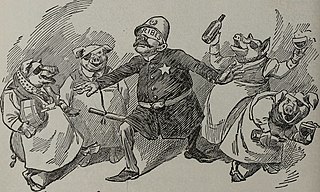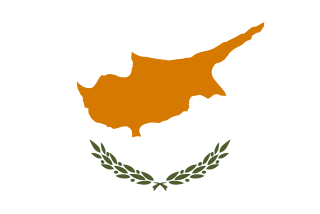
Police corruption is a form of police misconduct in which law enforcement officers end up breaking their political contract and abusing their power for personal gain. This type of corruption may involve one or a group of officers. Internal police corruption is a challenge to public trust, cohesion of departmental policies, human rights and legal violations involving serious consequences. Police corruption can take many forms, such as: bribery, theft, sexual assault, and discrimination.
The obshchak (Russian), obštšak, or ühiskassa (Estonian) or "common treasury" is a traditional umbrella organisation of criminal groups in Estonia, a trade union of sorts that settles conflicts and establishes boundaries of the spheres of interest of various groups such as the Estonian mafia and Russian mafia. Between 2003 and 2016, the Common Fund was dominated by Nikolai Tarankov (1953–2016) of Russian heritage and KGB training. However, Tarankov was found murdered in Haapsalu, apparently in a revenge murder related to his past actions. The Common Fund pays for lawyers of caught members, purchases and delivers packages to imprisoned members, and covers other expenses. The organization has about ten member groups. The members have also operated significantly in Finland, where in 2009, high-level drug dealing was controlled by Estonians.

Crime rates in Portugal are generally low, and most crimes are non-violent. Portugal's security and peace indicators compare favourably to those of other countries; According to the Institute for Economics and Peace's 2022 Global Peace Index report, Portugal ranks as the 6th most peaceful country in the world.

Crime in Russia refers to the multivalent issues of organized crime, extensive political and police corruption, and all aspects of criminality at play in Russia. Violent crime in Siberia is much more apparent than in Western Russia.

The Finnish Anti-Fascist Committee, also known by its Finnish abbreviation SAFKA, is a radical political organisation operating in Finland, founded in November 2008, but never registered. According to the Chairperson Johan Bäckman the committee has twenty activists and about a hundred supporters.

Erkki Johan Bäckman is a Finnish political activist, propagandist, author, eurosceptic, and convicted stalker working for the Russian government. Bäckman has been a prominent Finnish propagandist in Russia who has actively participated in long-standing operations to propagate anti-Finnish and anti-Western Russian propaganda.

Slovakia is a Central European country with a history of relatively low crime. While crime became more widespread after the Revolutions of 1989, it remains low when compared to many other post-communist countries.

Crime in Bulgaria is combated by the Bulgarian police and other agencies. The UK Government ranks Bulgaria as a low crime area and crime there has significantly decreased in recent years.

Crime in Germany is handled by the German police forces and other agencies.
Crime in Denmark is combated by the Danish Police and other agencies.

Crime in Hungary is combated by the Hungarian police and other agencies.

Finland's overall corruption is relatively low, according to public opinion and global indexes and standards. The 2023 Corruption Perceptions Index released by Transparency International scored Finland at 87 on a scale from 0 to 100. When ranked by score, Finland ranked second among the 180 countries in the Index, where the country or countries ranked first are perceived to have the most honest public sector. Finland has ranked first, second or third every year since the current version of the Index was introduced in 2012. For comparison with 2023 worldwide scores, the best score was 90, the average score was 43, and the worst score was 11. For comparison with regional scores, the highest score among Western European and European Union countries was 90, the average score was 65 and the lowest score was 42.

Corruption in Italy is a major problem. In Transparency International's annual surveys, Italy has consistently been regarded as one of the most corrupt countries in the Eurozone. Political corruption remains a major problem particularly in Lombardy, Campania and Sicily where corruption perception is at a high level. Political parties are ranked the most corrupt institution in Italy, closely followed by public officials and Parliament, according to Transparency International. But in the 2013 Global Corruption Barometer report, Italy is in 17th position in front of the United Kingdom (18th), Switzerland (21st) and the United States (22nd).

Crime is present in various forms in Laos.

In general, Belgium has a well-developed legal and institutional framework for fighting against corruption.

Corruption in Cyprus is a salient concern for people in Cyprus: As of 2022, 94% considered that corruption was widespread in the country.

Corruption in Slovakia is a serious and ongoing problem.

Corruption in Guinea-Bissau occurs at among the highest levels in the world. In Transparency International's Corruption Perceptions Index for 2023, Guinea-Bissau scored 22 on a scale from 0 to 100. When ranked by score, Guinea-Bissau ranked 158th among the 180 countries in the Index, where the country ranked first is perceived to have the most honest public sector. However, Guinea-Bissau's score has either improved or remained steady every year since its low point in 2018, when it scored 16. For comparison with worldwide scores, the best score in 2023 was 90, the average score was 43, and the worst score was 11. For comparison with regional scores, the average score among sub-Saharan African countries was 33. The highest score in sub-Saharan Africa was 71 and the lowest score was 11. In 2013, Guinea-Bissau scored below the averages for both Africa and West Africa on the Mo Ibrahim Foundation’s Index of African Governance.

Transparency International defines corruption as "the abuse of entrusted power for private gain". Transparency International's 2023 Corruption Perceptions Index scored the United Kingdom at 71 on a scale from 0 to 100. When ranked by score, the United Kingdom ranked 20th among the 180 countries in the Index, where the country ranked first is perceived to have the most honest public sector. For comparison with worldwide scores, the best score was 90, the average score was 43, and the worst score was 11. For comparison with regional scores, the highest score among Western European and European Union countries was 90, the average score was 65 and the lowest score was 42. The United Kingdom's score has fallen six points over the last five years and is now at its lowest point in the twelve years that the current version of the Index has been published.

Crime in Latvia is relatively low, by global standards, especially compared to previous years, when it was named the "crime capital of Europe" by Forbes in 2008. The homicide rate in Latvia was 4.9 per 100,000 people in 2020, a sharp drop from 10 cases per 100,000 people in 2000, and has been steadily decreasing, but has seen recent increases. The United States Department of State has assessed Latvia's security rating as "medium", with a moderate crime rate. In recent times, crime has been increasing, particularly due to many Latvians stranded because of the COVID-19 pandemic returning to Latvia and choosing to commit crime. According to Interpol, Latvia is considered an attractive place for regional and organized criminals involved in drug trafficking, arms trafficking, human trafficking, or smuggling. According to the Central Statistical Bureau of Latvia, a third of all women in Latvia have suffered some form of sexual violence or rape while men are subjected to violence outside the family.


















